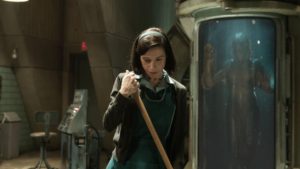In a dream-like state, the viewer floats through a blue underwater apartment filled with furniture and photographs, settling on the waking face of Eliza (Sally Hawkins). This magical setting opens director Guillermo del Toro’s The Shape of Water. The VFX team, lead by visual effects supervisor Dennis Berardi, helped create the photo realistic subaquatic environment.
“The water kept me up at night,” admitted Berardi. “There’s a fundamental math problem with water in that the computational requirements to render water are exponentially greater than standard rendering of static objects or creatures. It’s an order of magnitude just getting a version out for a director’s evaluation.”
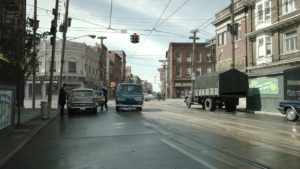 The director had a keen idea of what he wanted to see, but his process was exploratory. He was seeing dozens of versions a day, so a major technology upgrade with over 15,000 CPUs was needed to render the volume of water with expediency.
The director had a keen idea of what he wanted to see, but his process was exploratory. He was seeing dozens of versions a day, so a major technology upgrade with over 15,000 CPUs was needed to render the volume of water with expediency.
The world of the film takes on a nostalgic look that draws from classic Hollywood and 1950’s creature features. The production design and visual effects are seamless collaborators in immersing the viewer in the detailed world of the director’s vision. One of prerequisites of working with del Toro is that the VFX team needed to be able to replicate any set photo realistically in post-production in case the director wanted to make up a new shot. So every set was scanned so the team had creative latitude in post.
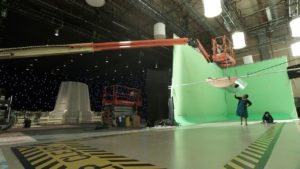 Developed through years of working on the concept and script, del Toro had accumulated sketches and notes to inform the creative crew of his visual intentions for the film. But although the world and watery settings posed challenges, the greatest challenge came from the amphibian man central to the story.
Developed through years of working on the concept and script, del Toro had accumulated sketches and notes to inform the creative crew of his visual intentions for the film. But although the world and watery settings posed challenges, the greatest challenge came from the amphibian man central to the story.
While finishing his previous movie, Crimson Peak, Guillermo gave Berardi the script. “It was amazing. It was moving,” remembered Berardi. “And I started to realize, and this was when the terror started to happen, that this creature has to be a leading man. It became this wonderful hybrid of the best of traditional filmmaking techniques, with amazing creature design from Shane Mahan and Mike Hill–and of course Guillermo who’s probably the foremost creature designer in the world–and what we could bring to it with visual effects.”
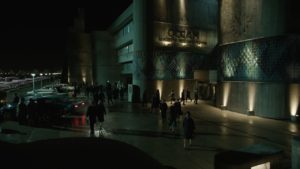 As his part of the collaboration, Berardi’s job was to help complete the performance. In portraying “amphibian man,” Doug Jones was acting through an inch of rubber. To understand where Jones was going with his performance, Berardi needed to figure out what the actor’s face was doing underneath the make-up.
As his part of the collaboration, Berardi’s job was to help complete the performance. In portraying “amphibian man,” Doug Jones was acting through an inch of rubber. To understand where Jones was going with his performance, Berardi needed to figure out what the actor’s face was doing underneath the make-up.
Facial capture technology recorded the performances. The team’s goal was to work from the eyes out. Every time the creature’s eyes are visible, with their blinks and nictitating membrane, they are are digital. “Those eyes had to be very deep and very soulful,” explained Berardi. “We had to add the blinks and the eye movement. Sometimes we’d do some dilations. Very subtle things to try and bring the emotion across.”
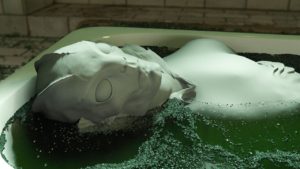
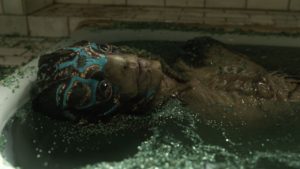 The VFX was a process of numerous iterations of each shot, slowly perfecting every performance. The filmmakers worked to integrate the visual effects into the original photography, unlike a film such as Planet of the Apes constructed of all motion capture and 100 percent digitally rendered characters.
The VFX was a process of numerous iterations of each shot, slowly perfecting every performance. The filmmakers worked to integrate the visual effects into the original photography, unlike a film such as Planet of the Apes constructed of all motion capture and 100 percent digitally rendered characters.
“This was a pure hybrid. For every shot of the creature in the movie, Doug is on set in the suit, lit by cinematographer Dan Laustsen,” said Berardi. “I went in and enhanced it and replaced only parts needed for performance or technical reasons.”
The only fully digital shots are when the creature is underwater or full body swimming. Those shots were digitally animated and photo-realistically rendered. One of the hardest parts of the job was “to convince Guillermo.” Berardi was working under del Toro’s directive to convince the audience that the creature was alive and to exactly match the digital version to the practical creature. The director did not want to be able to tell the difference between the two.
“We showed him a one to one match very early in the process and that’s when I knew we had cracked the creature,” revealed Berardi. “I could photo realistically render parts of him, usually the eyes, or all of him, and the audience shouldn’t be able to tell them apart. Always taking Doug’s performance as our main cue.”

